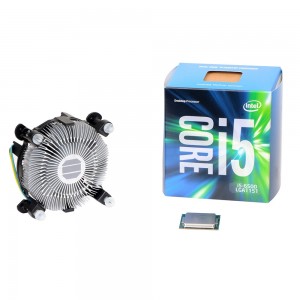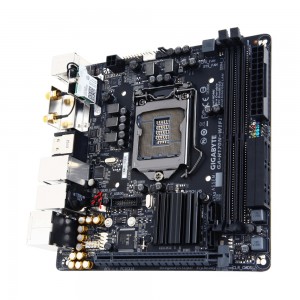 If you accidentally read the article Intel Skylake i7 6700k, i5 6600k vs. Haswell and Sandy Bridge Processors the other day, you probably have learned that the new 6th processor is a worthy upgrade over Sandy Bridge family that happened 4 generations ago.
If you accidentally read the article Intel Skylake i7 6700k, i5 6600k vs. Haswell and Sandy Bridge Processors the other day, you probably have learned that the new 6th processor is a worthy upgrade over Sandy Bridge family that happened 4 generations ago.
In term of raw performance, it’s somewhere in between 30-45% faster than Sandy Bridge plus Z170 chipset opens up opportunity for us to throw in a few DDR4 memory so our computer could be really advanced fast. The new architecture also makes use of NVMe protocol for on-board SSD via PCIe lanes, which is particularly ideal for a small footprint PC like this one we’re doing today.
Let’s compare note!
Intel i5 6500 LGA-1151My nerd friends declare they’d seriously considering leaving the basement for once and going Putin on me for not having the i7 6700k, or even i5 6600k in this build. Why they’d want that ? Because PC MASTER RACE, that’s why!
There is nothing wrong with i5 6600K if you got the extra $50 to spend, but you will then need to buy an additional CPU cooler to pair with. The i5 6500 is bundled with a stock cooler and has a TDP 65W while the unlocked 6600K is over 90W with no stock cooler. That means at the end of the day, the price difference is actually about 406 bananas (59 cents per three, that is) and you’ll have a hotter system to deal with. In our mini itx case, heat will be the cause of overall slow down, hence let’s push the pedal close to the rev limit but not over it. When it comes to performance race between the two, i5 6500 has a PassMark score of 7039, while i5 6600k delivers around 7785. That can be interpreted to a real world gain of a few extra seconds on the loading screen or during multi-core video encoding and photo editing tasks. Which either way, does not affect our truly in-game experience one bit and I’m sure we could live with that.
on sale
Intel Core i5 6500 3.20 GHz Quad Core Skylake Desktop Processor, Socket LGA 1151, 6MB Cache
|
Motherboard
Under further investigation you’d find that a few features are less or not available on H170 platform versus Z170, such as couple less USB 3.1 ports, no Smart Sound tech and most importantly, not as many PCIe lanes. On a typical ATX board with Z170 controller, you’re looking at two to three PCIe x8 lanes for SLI or Crossfire, a few more x4 and one or two x1 lanes for miscellaneous add-on cards. Yet the keyword is ATX. Our Mini-ITX could probably pack at most one full PCIe 3.0 x16 lane and that’s it! That means whatever bandwidth the H170 provides (20 HSIO lanes vs. 26) is already more than what we can force out of the motherboard. Which all comes down to overclocking feature. Well. In today build, I’ll gladly accept Gigabyte GA-H170N-WIFI as the beloved foundation for our gaming rig. It costs less than $120 and is packed with a handful of everything we need to run a serene, forever alone gaming session : Wireless-AC 867 Mbps, M.2 socket, 115dB SNR Audio chip, USB 3 Type C and two DIMM slots for dual channel DDR4’s. Another variation of this model is the GA-Z170N-Gaming 5 with more fancy HD audio controller, optimized ethernet chipset for MMO games and Digital PWM for overclocking purpose. Well.
Gigabyte LGA1151 Intel H170 Mini-ITX DDR4 Motherboard GA-H170N-WIFI
|
RAM16GB is slowly becoming a standard this year; though for most of the days, 8GB of RAM definitely give your system plenty of room to wiggle. But since our mobo is limit on the memory slot counts, let’s set it at 16GB once and not to worry about it again for awhile.
Ballistix Sport 16GB Kit (8GBx2) DDR4 2400MHz (PC4-19200) DIMM - BLS2K8G4D240FSA
|
StorageLet’s pick Samsung 950 Pro 256GB and a mechanical hard drive on the side. The reason why we pick 950 Pro is beyond the scoop of this article. One of the most important reasons is because my laziness prevents me from explaining it again, and it also consumes your valuable time. So I’m gonna send you over to our comparison guide at Samsung NVMe 950 Pro vs. 850 for more information when you got a chance. But don’t take that lightly, you definitely should read about it to get the best out of this SSD.
Samsung 950 PRO 256GB SSD (MZ-V5P256BW) V-NAND, M.2 NVM Express
HITACHI Deskstar 2TB 7200RPM 32MB Cache SATA 3.0Gb/s 3.5" Internal Desktop Hard Drive - (PC/Mac/CCTV DVR) w/1 Year Warranty
|
Power SupplyAs one of the most reliable ITX PSUs in the market and it has proven itself well in our last ITX build, we will once again look at the Silverstone SX600-G Fully Modular power supply for this machine. At 600 watts, the only things you can’t do with this baby is having a foursome with three GTX 980’s. Not likely that’ll happen at all. So that means 400-watt or 500-watt models will also be sufficient for the build. Pick the lesser one if you plan on just using the integrated HD graphics chipset.
SilverStone Technology 600W SFX Form Factor 80 PLUS GOLD Full Modular Power Supply with +12V single rail, Active PFC (SX600-G)
|
Video Cards
In my opinion the GTX 960 is a pretty cost-efficient video card that lets you play any games you want, but not too serious about maxing out all the visual settings just for kicks. NVIDIA GTX 950
ASUS GeForce GTX 950 Graphics Cards (GTX950-M-2GD5)
NVIDIA GTX 960
EVGA GeForce GTX 960 04G-P4-1962-KR 4GB SC GAMING, 6.8 Inch
NVIDIA GTX 970
Gigabyte GeForce GTX 970 Mini ITX Overclocked 4GB GDDR5 PCiE Video Card GV-N970IXOC-4GD
Radeon R9 Nano
Sapphire Radeon R9 Nano 4GB HBM HDMI/Triple DP PCI-Express Graphics Card 21249-00-40G
|
Chassis
Phanteks Enthoo Evolv iTX Case, Window PH-ES215P_BK Black
Phanteks Enthoo Evolv is a beautiful chassis with creative craftsmanship. You have a clean cable management system, a windowed side panel, PSU / HDD separate compartment at the bottom along with side bracket for SSD mount and space for up to 4 fans. It can support full-length video card so you might not even need to purchase a mini ITX GPU at all. The best feature that we like is location for a full pledge water cooling kit to be installed. What’s not to like ? No optical drive bay. Or perhaps its 14 inches height that’s slightly against our goal for a small ITX build. That’s tall enough for Jesse to pack all the meth bags inside instead of hiding them under the kitchen sink. If that was the case, please proceed with Silverstone Sugo SG05-Lite. Yes it’s the same one we used in the 2015 build. Below is the summary to save you a click.
|
Component |
Cost Estimate |
|
| CPU — Intel Boxed Core I5-6500 FC-LGA14C 3.20 Ghz | $195 | |
| MOBO — Gigabyte LGA1151 Intel H170 Mini-ITX DDR4 Motherboard GA-H170N-WIFI | $115 | |
| RAM — Crucial Ballistix Sport 16GB Kit (8GBx2) DDR4 2400 | $70 | |
| SSD — Samsung 950 PRO -Series 256GB PCIe NVMe – M.2 | $182 | |
| HDD — HITACHI Deskstar 2TB 7200RPM 32MB Cache | $54 | |
| PSU — SilverStone Technology 600W SFX Form Factor 80 PLUS GOLD Full Modular | $119 | |
| GPU — Gigabyte GeForce GTX 970 Mini ITX Overclocked 4GB | $320 | |
| CASE — Phanteks Enthoo Evolv iTX Case, | $69 | |
Total ~ $1124 |
||

















Temperature measurements?
Would be interesting if the case suits this whole build well.
Im planning on building something similar but would be interested in some measurements.
Could I do this build with the gtx 1070 itx coming out?
Yes, but it must be mini itx edition :)